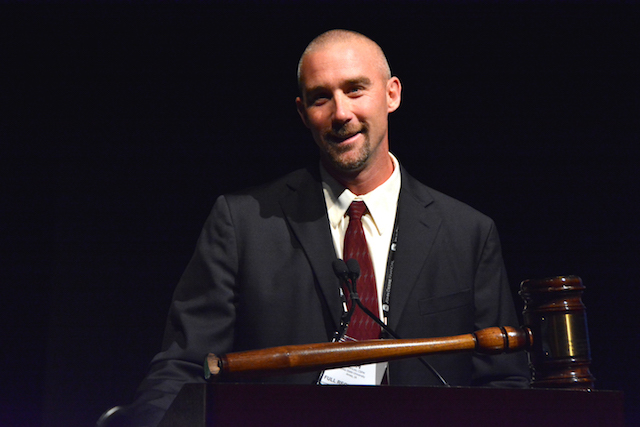By Wes Kleffner
Editor’s note: Photo above is of STMA President Tim Van Loo, CSFM
Everyone has strengths and weaknesses. Have you taken the time to identify yours? How often? Could these weaknesses inhibit you from reaching your short- or long-term goals?
Public speaking has always been an interest of mine. But, I struggled speaking in front of large groups. Many leaders in our nation’s history had the ability to be an effective public speaker. I reflect back on every presentation. I ask myself was the delivery communicated in a way my audience understood. Personal evaluations are difficult. Feedback from others can be more beneficial. They may see something that you do not. The trick is don’t give up. If it were easy everyone would do it. You must have the drive for improvement.
How do you become a great public speaker? I’m not sure anyone truly perfects public speaking but improves over time. Effective communication is important for your audience to understand the purpose of your speech. You must know your audience. This will help prepare you for questions, keeping them engaged, and providing pertinent information.
Have you heard the term Glossophobia? This is the extreme fear of public speaking. You may know someone that falls into this category. These people freeze up in front of audiences, tremble, and their faces often turn red. If you truly suffer from this phobia you shy away from any opportunity to speak in public. Some people may have challenges communicating. Please take one thing into consideration. Just because someone is not saying anything does not mean they are not listening. Listening is a huge part of effective communication. A presenter must listen not only with their ears but also with their eyes. Body language can tell you a lot about engagement of your audience. As you become a more crafted public speaker you begin to look for triggers. For instance if you notice restlessness with your audience, share a relevant funny story. Pick on yourself. Everyone has a funny story about a circumstance in his or her lives. Those are the easiest to remember!
What are your short and long term career goals? One long-term goal for me was moving into a turf industry sales role. Part of this job includes speaking in front of large groups. Public speaking was definitely stepping out of my comfort zone. On the other hand, I truly believe by challenging yourself leads to personal growth. Everyone has his or her own definition of personal growth. My definition would include activities that improve intelligence, talent development, and enhance employability. Some organizations, such as Toastmasters, and training courses in public speaking will help. A quick search on the web is a great start. It does not take long before you see information pertaining to Toastmasters.
Toastmasters began as a series of speaking clubs organized by Ralph C. Smedley in 1905 in Bloomington, IL. As director of education at a YMCA, Ralph recognized a need in the community to learn how to speak, conduct meetings, and work on committees. This led to the creation of Toastmasters. Soon after Ralph moved to San Jose, CA where he began working at a newly organized YMCA and spent 2 years finding a permanent location. His passion to help others learn to speak remained. Once the new YMCA building opened in April 1924, he was able to introduce the idea of Toastmasters to his colleagues.
Today there are two main educational programs within Toastmasters focused on competent communication and leadership. I am more familiar with the competent communication track of their program. This track contains 10 speeches. Each 5-minute speech focuses on different objectives. The first speech is the Ice Breaker. This is the easier speech of the program due to the fact you are introducing yourself to the audience. The second speech focuses on organization. By outlining listener’s better follow, understand, and remember your message. The third speech emphasizes on getting to the point. This helps determine the general and specific purpose. The next speech focuses on word selection. Selecting the appropriate partnership of words can be very persuading.
Body language is also important when you’re on stage. Your audience wants to see someone with high energy not someone simply reading from a script with their head down. High energy keeps engagement! The ability to use a vocal variety is important. Your voice should reflect the thoughts you are presenting. I personally like pauses to enhance messages.
Speech seven is all about researching a topic. Collecting facts from several sources to support a topic is critical to be effective. Visual aids also help get your point across! Knowing when, what, and how can be very persuasive. The ninth speech challenges presenters not to use notes. Memorizing a speech increases sincerity and conviction. The 10th and final speech focuses on inspiring your audience. Speeches are not simply written the night before a meeting. It is very common for me to begin writing speeches months in advance and practicing for hours.
The meetings themselves are very structured. The toastmaster calls the meeting to order and introduces everyone with a role, for example the “Ah-counter.” The purpose of this role is to note pause fillers from anyone during the meeting. The Grammarian also plays an important role. Their responsibility is to introduce a new word to the group and comment on the use of English. Every speech gets evaluated along with being timed according to requirements. Most everyone has a role but most importantly everyone speaks. A way to ensure this is by the table topic master. This person picks members in the group to speak on certain topics that helps members think on their feet. Toastmaster manuals are available online at https://www.toastmasters.org/education.
When presenting you really give three speeches. The speech you rehearse. The speech you present. The speech you wish you gave!
Wes Kleffner is with the Crop Science Division, Bayer CropScience, Overland Park, KS.


